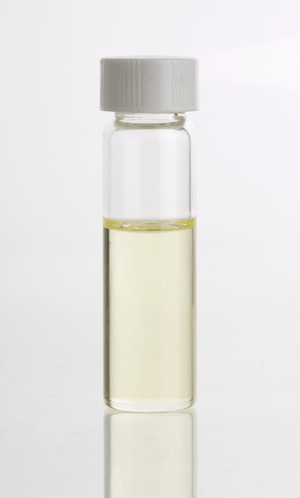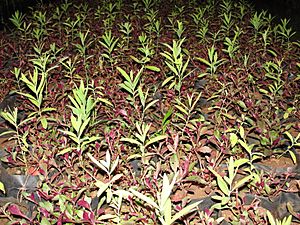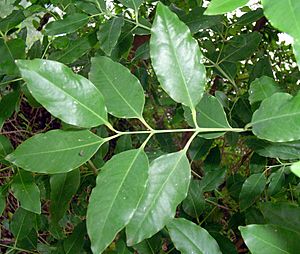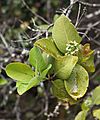Sandalwood facts for kids
Sandalwood is a special type of wood that smells very nice. It also refers to the oil made from this wood. People use sandalwood for making perfume and even for medicine. These trees grow in places like India, Australia, Indonesia, and the Pacific Islands. The scientific name for the group of plants it belongs to is Santalum. In countries like Indonesia and Malaysia, people call it Cendana.
Contents
How Sandalwood is Grown and Harvested
To get the best-smelling sandalwood oil, Santalum trees need to be at least 15 years old. This is when they are usually harvested in Western Australia. Older trees often have more oil and better quality oil.
Australia is becoming a big producer of Santalum album sandalwood. Much of it grows near Kununurra in Western Australia. Sandalwood is also grown on special farms called plantations. Over 15,000 hectares (about 37,000 acres) of these trees are planted east of Perth.
Sandalwood is quite expensive compared to other woods. To get the most valuable parts, the whole tree is removed, including the stump and roots. This is because the roots and stump also contain a lot of the precious sandalwood oil.
What is Sandalwood Used For?
Sandalwood's Special Scent

Sandalwood oil has a unique smell. It's soft, warm, creamy, and woody. This scent makes it a popular ingredient in many perfumes. It helps perfumes smell good for a long time.
Sandalwood is also used in "floriental" perfumes. These perfumes mix woody scents with the smell of white flowers. Examples of these flowers include jasmine, ylang ylang, gardenia, and orange blossom.
In India, sandalwood oil is widely used in the cosmetic industry. However, the main type of true sandalwood, Santalum album, is a protected species. This means there isn't enough of it to meet everyone's needs.
Many different plants are sometimes called "sandalwood." The Santalum group has over 19 types of trees. Sometimes, oils from similar plants are sold as sandalwood. But most of these alternative woods lose their smell after a few months or years.
Scientists have also created a man-made chemical called Isobornyl cyclohexanol. It smells like sandalwood and is used as an alternative.
Sandalwood oil is mostly made up of two chemicals called santalol. These make up about 75% of the oil. Sandalwood is used in aromatherapy and to make soaps.
Images for kids
-
Santalum paniculatum (ʻiliahi), a type of sandalwood from Hawaiʻi
-
A statue of Lord Ganesha carved from sandalwood







